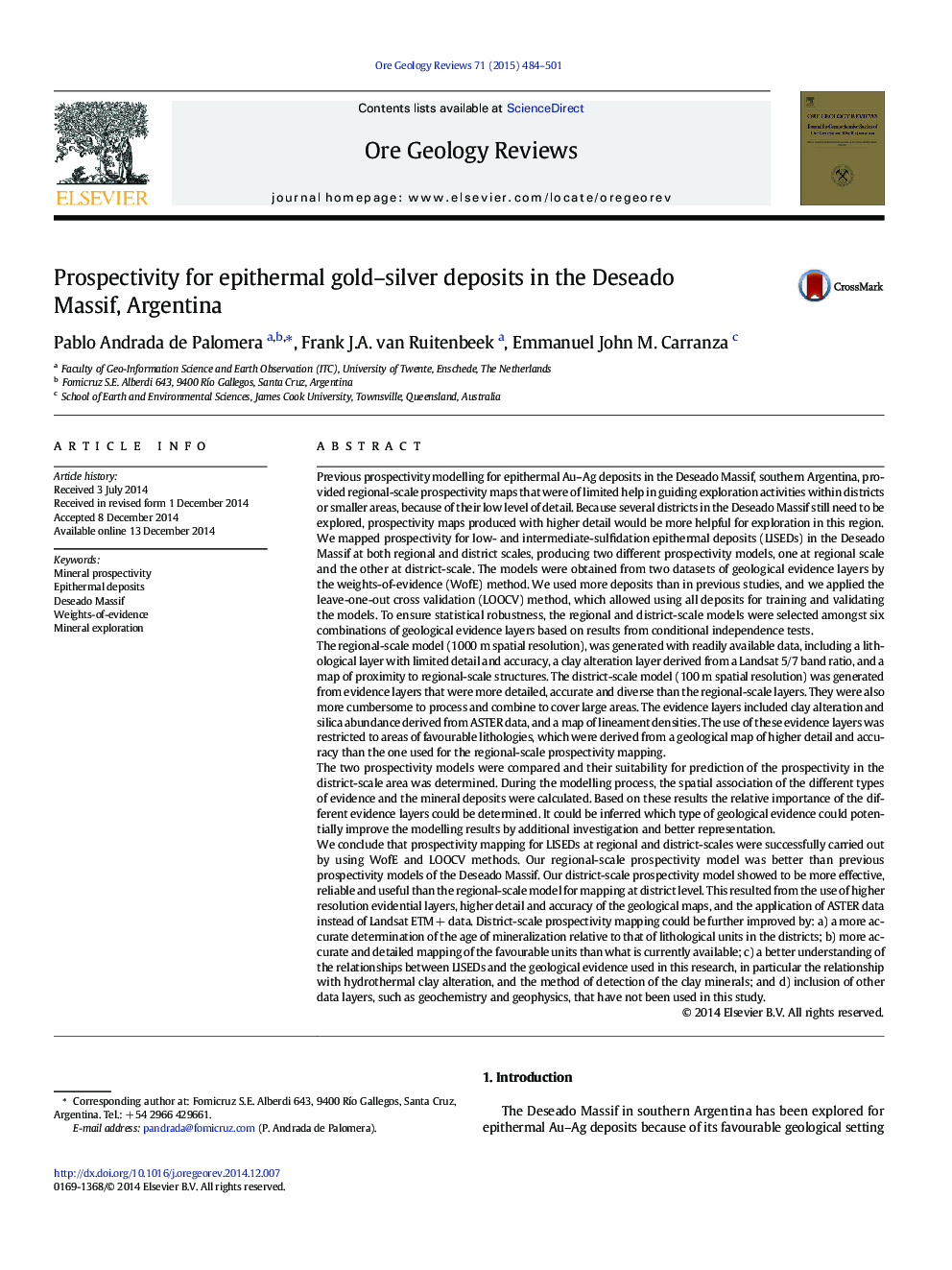| کد مقاله | کد نشریه | سال انتشار | مقاله انگلیسی | نسخه تمام متن |
|---|---|---|---|---|
| 4697034 | 1637233 | 2015 | 18 صفحه PDF | دانلود رایگان |

• Prospectivity was mapped at regional- and district-scales improving previous mapping.
• Accuracy and detail of geological maps are keys to improve district-scale prospectivity mapping.
• Prospectivity can improve by studying hydrothermal alterations and the ways to detect them.
Previous prospectivity modelling for epithermal Au–Ag deposits in the Deseado Massif, southern Argentina, provided regional-scale prospectivity maps that were of limited help in guiding exploration activities within districts or smaller areas, because of their low level of detail. Because several districts in the Deseado Massif still need to be explored, prospectivity maps produced with higher detail would be more helpful for exploration in this region.We mapped prospectivity for low- and intermediate-sulfidation epithermal deposits (LISEDs) in the Deseado Massif at both regional and district scales, producing two different prospectivity models, one at regional scale and the other at district-scale. The models were obtained from two datasets of geological evidence layers by the weights-of-evidence (WofE) method. We used more deposits than in previous studies, and we applied the leave-one-out cross validation (LOOCV) method, which allowed using all deposits for training and validating the models. To ensure statistical robustness, the regional and district-scale models were selected amongst six combinations of geological evidence layers based on results from conditional independence tests.The regional-scale model (1000 m spatial resolution), was generated with readily available data, including a lithological layer with limited detail and accuracy, a clay alteration layer derived from a Landsat 5/7 band ratio, and a map of proximity to regional-scale structures. The district-scale model (100 m spatial resolution) was generated from evidence layers that were more detailed, accurate and diverse than the regional-scale layers. They were also more cumbersome to process and combine to cover large areas. The evidence layers included clay alteration and silica abundance derived from ASTER data, and a map of lineament densities. The use of these evidence layers was restricted to areas of favourable lithologies, which were derived from a geological map of higher detail and accuracy than the one used for the regional-scale prospectivity mapping.The two prospectivity models were compared and their suitability for prediction of the prospectivity in the district-scale area was determined. During the modelling process, the spatial association of the different types of evidence and the mineral deposits were calculated. Based on these results the relative importance of the different evidence layers could be determined. It could be inferred which type of geological evidence could potentially improve the modelling results by additional investigation and better representation.We conclude that prospectivity mapping for LISEDs at regional and district-scales were successfully carried out by using WofE and LOOCV methods. Our regional-scale prospectivity model was better than previous prospectivity models of the Deseado Massif. Our district-scale prospectivity model showed to be more effective, reliable and useful than the regional-scale model for mapping at district level. This resulted from the use of higher resolution evidential layers, higher detail and accuracy of the geological maps, and the application of ASTER data instead of Landsat ETM + data. District-scale prospectivity mapping could be further improved by: a) a more accurate determination of the age of mineralization relative to that of lithological units in the districts; b) more accurate and detailed mapping of the favourable units than what is currently available; c) a better understanding of the relationships between LISEDs and the geological evidence used in this research, in particular the relationship with hydrothermal clay alteration, and the method of detection of the clay minerals; and d) inclusion of other data layers, such as geochemistry and geophysics, that have not been used in this study.
Journal: Ore Geology Reviews - Volume 71, December 2015, Pages 484–501